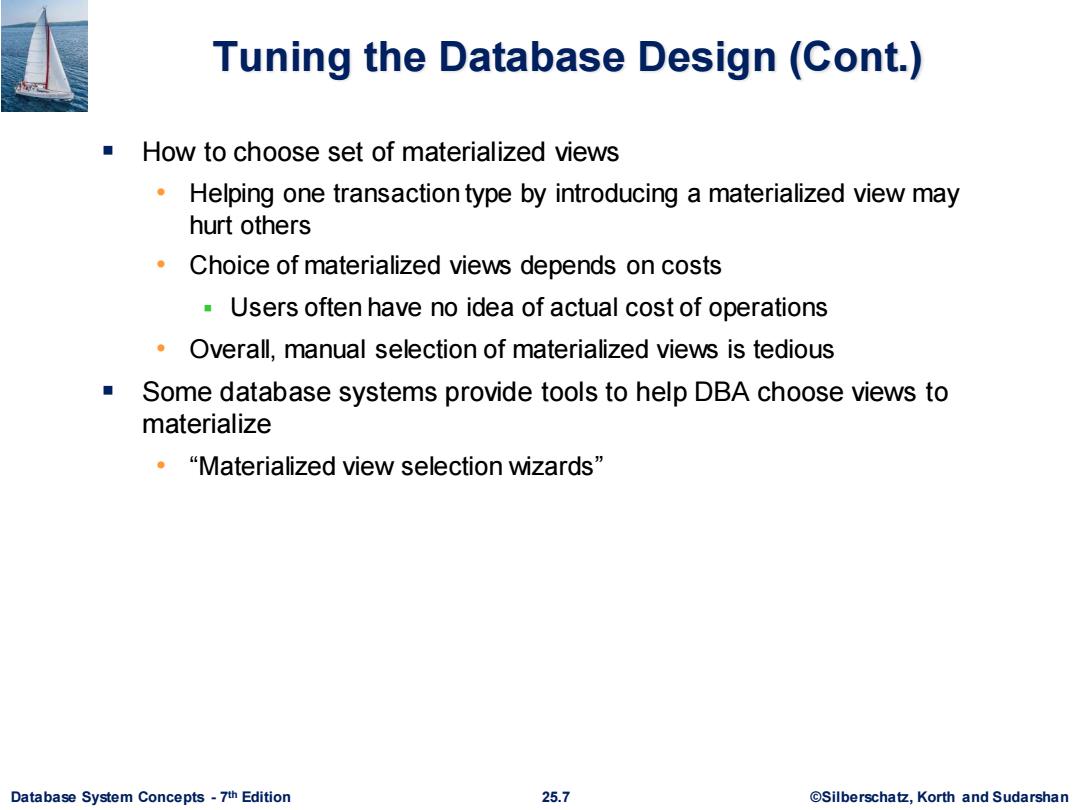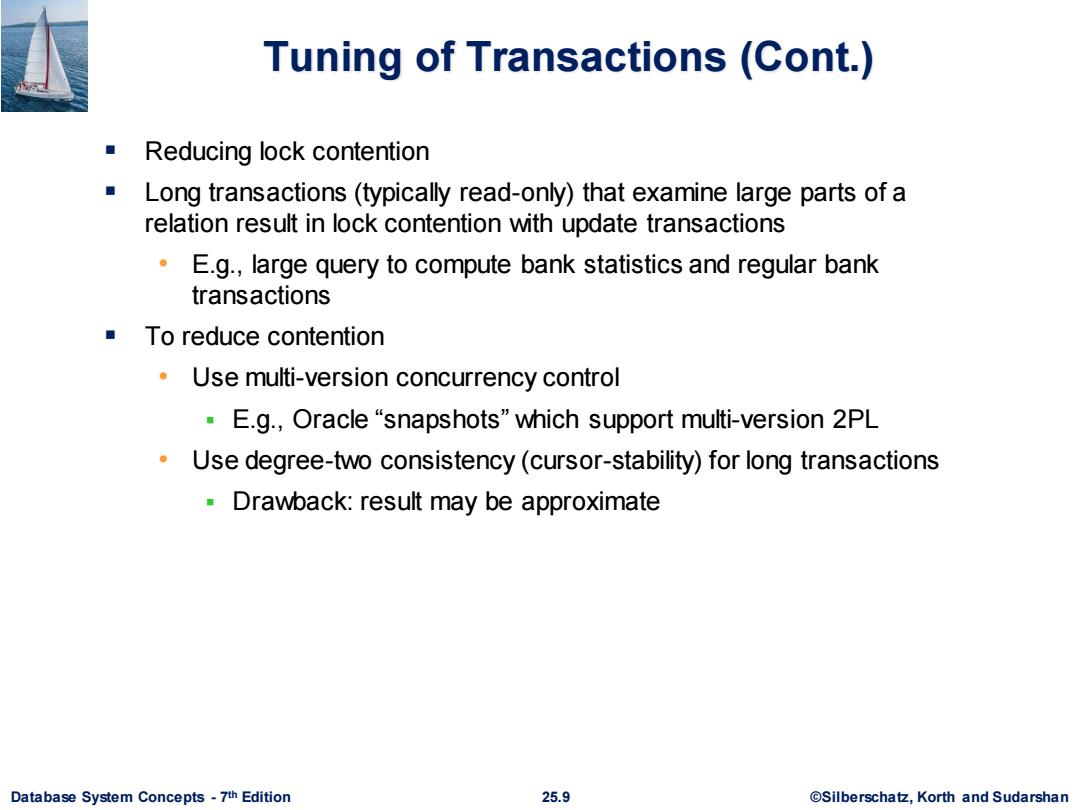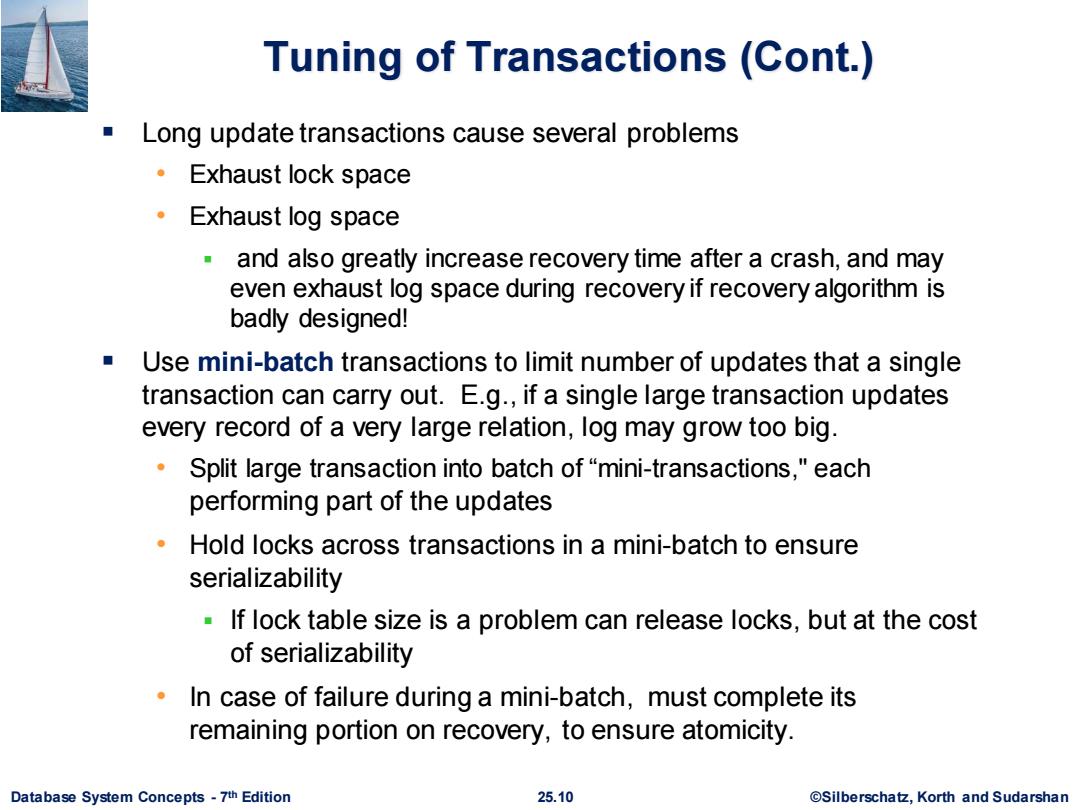
Hardware Tuning:Choice of RAID Level ■To use RAID1 or RAID5? Depends on ratio of reads and writes RAID 5 requires 2 block reads and 2 block writes to write out one data block If an application requires r reads and w writes per second RAID 1 requires r+2w l/O operations per second RAID 5 requires:r+4w 1/O operations per second For reasonably large r and w,this requires lots of disks to handle workload RAID 5 may require more disks than RAID 1 to handle load! Apparent saving of number of disks by RAID 5(by using parity,as opposed to the mirroring done by RAID 1)may be illusory! Thumb rule:RAID 5 is fine when writes are rare and data is very large,but RAID 1 is preferable otherwise If you need more disks to handle 1/O load,just mirror them since disk capacities these days are enormous! Database System Concepts-7th Edition 25.3 ©Silberscha乜,Korth and Sudarshan
Database System Concepts - 7 25.3 ©Silberschatz, Korth and Sudarshan th Edition Hardware Tuning: Choice of RAID Level ▪ To use RAID 1 or RAID 5? • Depends on ratio of reads and writes ▪ RAID 5 requires 2 block reads and 2 block writes to write out one data block ▪ If an application requires r reads and w writes per second • RAID 1 requires r + 2w I/O operations per second • RAID 5 requires: r + 4w I/O operations per second ▪ For reasonably large r and w, this requires lots of disks to handle workload • RAID 5 may require more disks than RAID 1 to handle load! • Apparent saving of number of disks by RAID 5 (by using parity, as opposed to the mirroring done by RAID 1) may be illusory! ▪ Thumb rule: RAID 5 is fine when writes are rare and data is very large, but RAID 1 is preferable otherwise • If you need more disks to handle I/O load, just mirror them since disk capacities these days are enormous!

Tuning the Database Design (Cont.) Materialized Views Materialized views can help speed up certain queries Particularly aggregate queries ■Overheads ·Space Time for view maintenance Immediate view maintenance:done as part of update txn time overhead paid by update transaction Deferred view maintenance:done only when required update transaction is not affected,but system time is spent on view maintenance until updated,the view may be out-of-date Preferable to denormalized schema since view maintenance is systems responsibility,not programmers Avoids inconsistencies caused by errors in update programs Database System Concepts-7th Edition 25.6 ©Silberscha乜,Korth and Sudarshan
Database System Concepts - 7 25.6 ©Silberschatz, Korth and Sudarshan th Edition Tuning the Database Design (Cont.) Materialized Views ▪ Materialized views can help speed up certain queries • Particularly aggregate queries ▪ Overheads • Space • Time for view maintenance ▪ Immediate view maintenance: done as part of update txn • time overhead paid by update transaction ▪ Deferred view maintenance: done only when required • update transaction is not affected, but system time is spent on view maintenance ▪ until updated, the view may be out-of-date ▪ Preferable to denormalized schema since view maintenance is systems responsibility, not programmers • Avoids inconsistencies caused by errors in update programs

Tuning the Database Design (Cont.) How to choose set of materialized views Helping one transaction type by introducing a materialized view may hurt others Choice of materialized views depends on costs Users often have no idea of actual cost of operations Overall,manual selection of materialized views is tedious ■ Some database systems provide tools to help DBA choose views to materialize ·“Materialized view selection wizards” Database System Concepts-7th Edition 25.7 ©Silberscha乜,Korth and Sudarshan
Database System Concepts - 7 25.7 ©Silberschatz, Korth and Sudarshan th Edition Tuning the Database Design (Cont.) ▪ How to choose set of materialized views • Helping one transaction type by introducing a materialized view may hurt others • Choice of materialized views depends on costs ▪ Users often have no idea of actual cost of operations • Overall, manual selection of materialized views is tedious ▪ Some database systems provide tools to help DBA choose views to materialize • “Materialized view selection wizards

Tuning of Transactions (Cont.) Reducing lock contention Long transactions(typically read-only)that examine large parts of a relation result in lock contention with update transactions E.g.,large query to compute bank statistics and regular bank transactions To reduce contention Use multi-version concurrency control ·E.g,Oracle“snapshots”which support multi-version2PL Use degree-two consistency(cursor-stability)for long transactions Drawback:result may be approximate Database System Concepts-7th Edition 25.9 ©Silberscha乜,Korth and Sudarshan
Database System Concepts - 7 25.9 ©Silberschatz, Korth and Sudarshan th Edition Tuning of Transactions (Cont.) ▪ Reducing lock contention ▪ Long transactions (typically read-only) that examine large parts of a relation result in lock contention with update transactions • E.g., large query to compute bank statistics and regular bank transactions ▪ To reduce contention • Use multi-version concurrency control ▪ E.g., Oracle “snapshots” which support multi-version 2PL • Use degree-two consistency (cursor-stability) for long transactions ▪ Drawback: result may be approximate

Tuning of Transactions (Cont.) Long update transactions cause several problems ·Exhaust lock space Exhaust log space and also greatly increase recovery time after a crash,and may even exhaust log space during recovery if recovery algorithm is badly designed! Use mini-batch transactions to limit number of updates that a single transaction can carry out.E.g.,if a single large transaction updates every record of a very large relation,log may grow too big. Split large transaction into batch of"mini-transactions,"each performing part of the updates Hold locks across transactions in a mini-batch to ensure serializability If lock table size is a problem can release locks,but at the cost of serializability In case of failure during a mini-batch,must complete its remaining portion on recovery,to ensure atomicity. Database System Concepts-7th Edition 25.10 ©Silberscha乜,Korth and Sudarshan
Database System Concepts - 7 25.10 ©Silberschatz, Korth and Sudarshan th Edition Tuning of Transactions (Cont.) ▪ Long update transactions cause several problems • Exhaust lock space • Exhaust log space ▪ and also greatly increase recovery time after a crash, and may even exhaust log space during recovery if recovery algorithm is badly designed! ▪ Use mini-batch transactions to limit number of updates that a single transaction can carry out. E.g., if a single large transaction updates every record of a very large relation, log may grow too big. • Split large transaction into batch of “mini-transactions,'' each performing part of the updates • Hold locks across transactions in a mini-batch to ensure serializability ▪ If lock table size is a problem can release locks, but at the cost of serializability • In case of failure during a mini-batch, must complete its remaining portion on recovery, to ensure atomicity